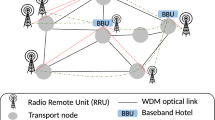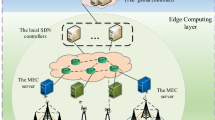Abstract
To address the limitations of current radio access networks (RANs), centralized RANs adopting the concept of flexible splits of the BBU functions between radio units (RUs) and the central unit have been proposed. This concept can be implemented combining both the Mobile Edge Computing model and relatively large-scale centralized Data Centers. This architecture requires high-bandwidth/low-latency optical transport networks interconnecting RUs and compute resources adopting SDN control. This paper proposes a novel mathematical model based on Evolutionary Game Theory that allows to dynamically identify the optimal split option with the objective to unilaterally minimize the infrastructure operational costs in terms of power consumption. Optimal placement of the SDN controllers is determined by a heuristic algorithm in such a way that guarantees the stability of the whole system. Finally, multi-agent learning methods were investigated in order to expand the model to more sophisticated scenarios where many RUs with limited information are interacting.





Similar content being viewed by others
References
Tzanakaki, et al.: Wireless-optical network convergence: enabling the 5G architecture to support operational and end-user services. IEEE Commun. Mag. 55(10), 184–192 (2017). https://doi.org/10.1109/mcom.2017.1600643
5G and Verticals ‹ 5G-PPP, 5g-ppp.eu, 2019. https://5g-ppp.eu/verticals/. Accessed 30 Oct 2019
5G Network Slicing for Vertical Industries, Huawei.com, 2019. https://www.huawei.com/minisite/5g/img/5g-network-slicing-for-vertical-industries-en.pdf. Accessed 30 Oct 2019
Kamel, M., Hamouda, W., Youssef, A.: Ultra-dense networks: a survey. IEEE Commun. Surv. Tutor. 18(4), 2522–2545 (2016). https://doi.org/10.1109/comst.2016.2571730
View on 5G Architecture, 5g-ppp.eu, 2019. https://5g-ppp.eu/wp-content/uploads/2018/01/5G-PPP-5G-Architecture-White-Paper-Jan-2018-v2.0.pdf. 30 Oct 2019
Liu, H., Eldarrat, F., Alqahtani, H., Reznik, A., de Foy, X., Zhang, Y.: Mobile edge cloud system: architectures, challenges, and approaches. IEEE Syst. J. 12(3), 2495–2508 (2018). https://doi.org/10.1109/jsyst.2017.2654119
Cloud RAN and MEC: A Perfect Pairing, Etsi.org, 2019. https://www.etsi.org/images/files/ETSIWhitePapers/etsi_wp23_MEC_and_CRAN_ed1_FINAL.pdf. Accessed 30 Oct 2019
What is enhanced Mobile Broadband (eMBB), 5g.co.uk, 2019. https://5g.co.uk/guides/what-is-enhanced-mobile-broadband-embb/.Accessed 30 Oct 2019
eCPRI Specification V1.1, Cpri.info, 2019. https://www.cpri.info/downloads/eCPRI_v_1_1_2018_01_10.pdf. Accessed 30 Oct 2019
Software-Defined Networking (SDN) Definition—Open Networking Foundation, Open Networking Foundation, 2019. https://www.opennetworking.org/sdn-definition/ . Accessed 30 Oct 2019
Heller, B., Sherwood, R., McKeown, N.: The controller placement problem. ACM SIGCOMM Comput. Commun. Rev. 42(4), 473 (2012). https://doi.org/10.1145/2377677.2377767
Hock, D., et al.: Pareto-Optimal resilient controller placement in SDN-based Core networks. In: IEEE Proceedings of the 2013 25th International Teletraffic Congress (ITC), 10–12 Sep 2013, Shanghai, China. https://doi.org/10.1109/ITC.2013.6662939
Noormohammadpour, M., Raghavendra, C.S.: "Datacenter traffic control: understanding techniques and tradeoffs. IEEE Commun. Surv. Tutor. 20(2), 1492–1525 (2018)
Weibull, J.: Evolutionary Game Theory. MIT Press, Cambridge (2004)
Yi, T., Zuwang, W.: Effect of time delay and evolutionarily stable strategy. J.Theor. Biol. 187(1), 111–116 (1997). https://doi.org/10.1006/jtbi.1997.0427
Obando, G., Poveda, J., Quijano, N.: Replicator dynamics under perturbations and time delays. Math. Control Signals Syst. (2016). https://doi.org/10.1007/s00498-016-0170-9
Anastasopoulos, N., Asteriou, D.: Optimal dynamic auditing based on game theory. Oper Res Int J (2019). https://doi.org/10.1007/s12351-019-00491-3
Anastasopoulos, N.P., Anastasopoulos, M.P.: The evolutionary dynamics of audit. Eur. J. Oper. Res. 216, 469–476 (2012)
Bloembergen, D., Tuyls, K., Hennes, D., Kaisers, M.: Evolutionary dynamics of multi-agent learning: a survey. J. Artif. Intell. Res. 53, 659–697 (2015). https://doi.org/10.1613/jair.4818
Wiering, M., Otterlo, M.: Reinforcement Learning. Springer, Berlin (2014)
Hernandez-Leal, P., Kaisers, M., Baarslag, T., Munoz de Cote, E.: A survey of learning in multiagent environments: dealing with non-stationarity. arXiv vol. 170709183, 2017. Accessed 5 Nov. 2019
Busoniu, L., Babuska, R., De Schutter, B.: A comprehensive survey of multiagent reinforcement learning. IEEE Trans. Syst. Man Cybern. Part C (Appl. Rev.) 38(2), 156–172 (2008). https://doi.org/10.1109/TSMCC.2007.913919
Börgers, T., Sarin, R.: Learning through reinforcement and replicator dynamics. J. Econ. Theory 77(1), 1–14 (1997). https://doi.org/10.1006/jeth.1997.2319
Tuyls, K., Hoen, P.J.T., Vanschoenwinkel, B.: An evolutionary dynamical analysis of multi-agent learning in iterated games. J. Auton. Agents Multi Agent Syst. 12(1), 115–153 (2006)
Panait, L., Tuyls, K., Luke, S.: Theoretical advantages of lenient learners: an evolutionary game theoretic perspective. J. Mach. Learn. Res. 9, 423–457 (2008)
Klos, T., Ahee, G.J.V., Tuyls, K.: Evolutionary dynamics of regret minimization. Technical report, 2010
Wübben, et al.: Benefits and impact of cloud computing on 5g signal processing. In: IEEE Signal Processing Magazine, pp. 35–44, November 2014
Desset, C., et al.: Flexible power modeling of LTE base stations. In: IEEE Wireless Communications and Networking Conference (WCNC), Shanghai, China, April, 2012
Xia, Y., Tse, D.: Inference of link delay in communication networks. IEEE J. Sel. Areas Commun. 24(12), 2235–2248 (2006)
Ben Khalifa, N., et.al.: Random time delays in evolutionary game dynamics. In: Proceedings of IEEE CDC, Osaka, Japan, pp. 3840–3845
Bernard, S., et al.: Sufficient conditions for stability of linear differential equations with distributed delay. Discrete Contin. Dyn. Syst. B 1(2), 233–256 (2001). https://doi.org/10.3934/dcdsb.2001.1.233
Baliga, J., et al.: Energy consumption in optical IP networks. J. Lightwave Technol. 27, 2391–2403 (2009)
Platform Overview. https://www.opendaylight.org.
Mininet Overview. https://mininet.org/overview/
Student's t-distribution. https://en.wikipedia.org/wiki/Student%27s_t-distribution
Acknowledgements
This work has been financially supported partly by a State Scholarships Foundation (IKY) scholarship and funded by the Act "Strengthening Human Resource Efficiency through the Implementation of Doctoral Research" from the resources of the OP "Human Resources Development, Education and Lifelong Learning," 2014–2020, the EU Horizon 2020 project 5G-COMPLETE under Grant Agreement No. 871900 and the EU Horizon 2020 project 5G-PICTURE under Grant Agreement No. 762057.
Author information
Authors and Affiliations
Corresponding author
Additional information
Publisher's Note
Springer Nature remains neutral with regard to jurisdictional claims in published maps and institutional affiliations.
Rights and permissions
About this article
Cite this article
Alevizaki, VM., Anastasopoulos, M., Tzanakaki, A. et al. Adaptive FH optimization in MEC-assisted 5G environments. Photon Netw Commun 40, 209–220 (2020). https://doi.org/10.1007/s11107-020-00906-8
Received:
Accepted:
Published:
Issue Date:
DOI: https://doi.org/10.1007/s11107-020-00906-8




